Motorola Adds The Moto Z Play Droid, Reveals Pricing For Unlocked Versions
by Matt Humrick on August 31, 2016 2:30 PM EST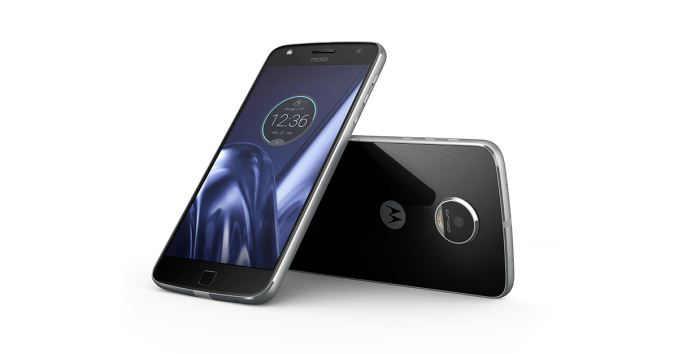
Motorola’s modular Moto Z family gets a new member today. The Moto Z Play Droid costs less than the Moto Z Droid and Moto Z Force Droid, both of which went on sale just over one month ago, and while it maintains full compatibility with Motorola’s Moto Mods and retains the same design language, there are some interesting hardware differences.
The Moto Z Play Droid still uses a 5.5-inch Samsung AMOLED display like its brothers, but resolution drops to 1920x1080. Because of the PenTile subpixel layout, the effective pixel density is less than a 1080p LCD of the same size. For this reason, we prefer a 1440p (QHD) resolution for phablet-sized displays to mitigate the loss in sharpness and color artifacts caused by PenTile’s diamond layout. To my aged eyes, the difference between the Moto Z Play Droid’s 1080p display and the Moto Z Droid’s 1440p display is small but noticeable.
Fortunately, the Moto Z Play comes with two user-selectable color modes: a “Standard” mode calibrated for the sRGB color space and a “Vibrant” mode that takes advantage of the AMOLED panel’s wider color gamut to display more vivid colors. While we have not tested the Moto Z Play, the other two Moto Zs performed pretty well in our display performance tests apart from a cool white point that reduced grayscale accuracy.
| Motorola Moto Z Droid Family | |||
| Moto Z Play Droid | Moto Z Droid | Moto Z Force Droid | |
| SoC | Qualcomm Snapdragon 625 (MSM8953) 8x Cortex-A53 @ 2.0GHz Adreno 506 @ 650MHz |
Qualcomm Snapdragon 820 (MSM8996) 2x Kryo @ 2.15GHz 2x Kryo @ 1.59GHz Adreno 530 @ 624MHz |
Qualcomm Snapdragon 820 (MSM8996) 2x Kryo @ 2.15GHz 2x Kryo @ 1.59GHz Adreno 530 @ 624MHz |
| RAM | 3GB LPDDR3-1866 | 4GB LPDDR4-3188 | 4GB LPDDR4-3188 |
| NAND | 32GB (eMMC 5.1) + microSD |
32GB / 64GB (UFS 2.0) + microSD |
32GB / 64GB (UFS 2.0) + microSD |
| Display | 5.5-inch 1920x1080 SAMOLED Corning Gorilla Glass |
5.5-inch 2560x1440 SAMOLED Corning Gorilla Glass |
5.5-inch 2560x1440 SAMOLED Moto ShatterShield |
| Dimensions | 156.4 x 76.4 x 6.99 mm 165 grams |
153.3 x 75.3 x 5.19 mm 136 grams |
155.9 x 75.8 x 6.99 mm 163 grams |
| Modem | Qualcomm X9 (Integrated) 2G / 3G / 4G LTE (Category 7) |
Qualcomm X12 (Integrated) 2G / 3G / 4G LTE (Category 12/13) |
Qualcomm X12 (Integrated) 2G / 3G / 4G LTE (Category 12/13) |
| SIM Size | NanoSIM | NanoSIM | NanoSIM |
| Front Camera | 5MP, 1/4" OmniVision OV5693, 1.4µm pixels, f/2.2, Auto HDR, LED flash | 5MP, 1/4" OmniVision OV5693, 1.4µm pixels, f/2.2, Auto HDR, LED flash | 5MP, 1/4" OmniVision OV5693, 1.4µm pixels, f/2.2, Auto HDR, LED flash |
| Rear Camera | 16MP, 1/2.4" OmniVision OV16860, 1.3µm pixels, f/2.0, PDAF + Laser AF, Auto HDR, dual-color LED flash | 13MP, 1/3.06" Sony IMX214 Exmor RS, 1.12µm pixels, f/1.8, Laser AF, OIS, Auto HDR, dual-color LED flash | 21MP, 1/2.4" Sony IMX338 Exmor RS, 1.12µm pixels, f/1.8, PDAF + Laser AF, OIS, Auto HDR, dual-color LED flash |
| Battery | 3510 mAh non-removable |
2600 mAh non-removable |
3500 mAh non-removable |
| Connectivity | 802.11a/b/g/n, BT 4.0 LE, NFC, GPS/GNSS, USB Type-C, Moto Mods connector | 802.11a/b/g/n/ac 2x2 MIMO, BT 4.1 LE, NFC, GPS/GNSS, USB Type-C, Moto Mods connector | 802.11a/b/g/n/ac 2x2 MIMO, BT 4.1 LE, NFC, GPS/GNSS, USB Type-C, Moto Mods connector |
| Launch OS | Android 6.0.1 | Android 6.0.1 | Android 6.0.1 |
| Launch Price (No Contract) |
$408 ($17/mo) | $624 ($26/mo) / $674 | $720 ($30/mo) / $770 |
There are differences inside the Moto Z Play too. Most significantly is a switch from Qualcomm’s Snapdragon 820 SoC to the Snapdragon 625, which includes eight ARM Cortex-A53 CPU cores running at up to 2.0GHz and a slimmed down Adreno 506 GPU that supports the latest OpenGL ES 3.1 and Vulkan graphics APIs. The SoC is paired with 3GB of LPDDR3 RAM that should provide sufficient bandwidth for this SoC and enough room for efficient multitasking with the Moto Z Play’s near-stock Android OS.
The Qualcomm X9 modem that comes integrated within the Snapdragon 625 SoC supports 2x20 MHz carrier aggregation on both the downlink and uplink, providing up to 300 Mb/s and 150 Mb/s, respectively. Other connectivity options include Bluetooth 4.0 LE, NFC, and Wi-Fi, although the latter option receives a downgrade relative to the other Moto Zs. Instead of 802.11ac and 2x2 MIMO, the Moto Z Play only supports 802.11n over 2.4GHz and 5GHz bands.
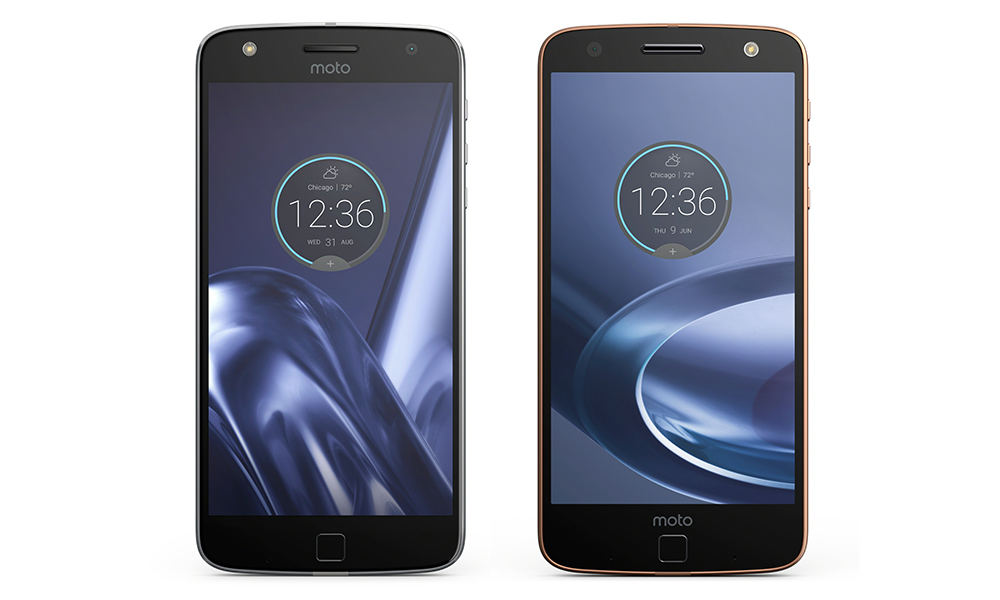
Moto Z Play Droid (left) and Moto Z Force Droid (right)
The Moto Z Play also packs in a 3510 mAh battery, basically the same size as the Moto Z Force, that when combined with the relatively low-power A53 CPU cores in the Snapdragon 625—manufactured on Samsung’s 14nm LPP FinFET process—should result in good battery life. It also includes Motorola’s TurboPower rapid charging technology and ships with the same 15W charger with permanently attached cord as the Moto Z Droid.
All three Moto Zs use the same 5MP front-facing camera with automatic HDR imaging and a dedicated LED flash. The rear cameras are all different, however. The Moto Z Play’s rear camera looks like an upgrade over the standard Moto Z’s and is very similar to the Moto Z Force’s camera, at least on paper. The 16MP OmniVision PureCel Plus-S sensor includes a buried color filter array and deep trench isolation (DTI) technology to reduce electrical crosstalk and improve color fidelity. The stacked die uses larger 1.3µm pixels that improve full-well capacity too. It uses the same hybrid autofocus system as the Moto Z Force that combines laser AF, phase detect AF (PDAF), and standard contrast AF to improve focusing speed and accuracy over a broad range of lighting conditions. The Moto Z Play does give up OIS, however, and its f/2.0 aperture has 13% less area than the Moto Z Force, but 31% more area than the Moto Z.
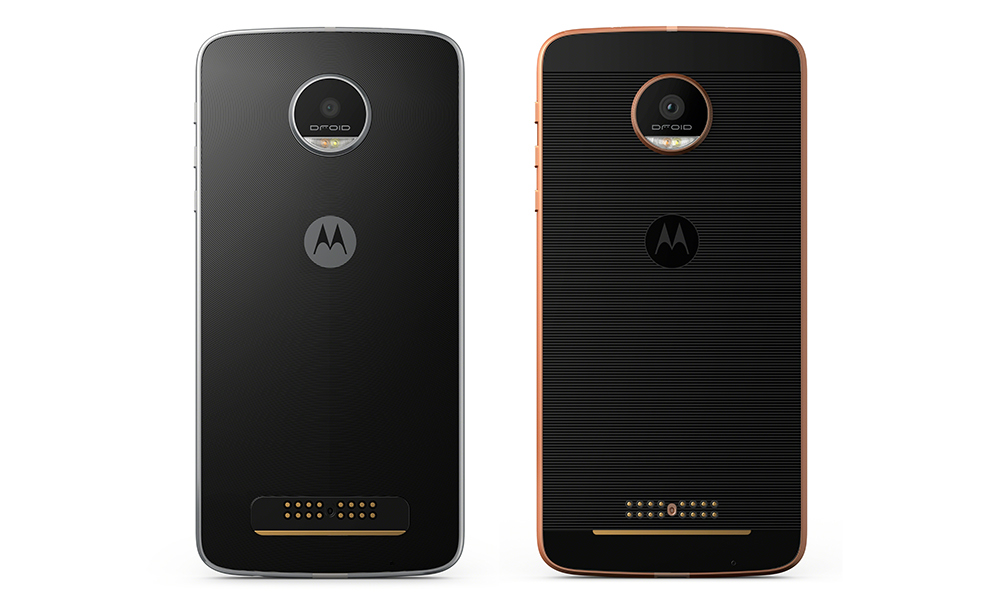
Moto Z Play Droid (left) and Moto Z Force Droid (right)
The Moto Z Play looks very similar to the other two Moto Zs with a few minor differences. It has the same thickness and nearly the same dimensions as the Moto Z Force, but its smooth metal sides, which lack the Force’s double taper, make it just a little more difficult to pick up from a table. A combination NanoSIM and microSD card tray and one of three microphones are located on the top edge, while a USB Type-C port is centered on the bottom edge. There’s also a 3.5mm headphone jack on the bottom, an analog port the other Moto Zs lack.
The back of the phone is still flat with a proprietary connector near the bottom to accommodate Motorola’s Moto Mod accessories. The same raised, circular camera module is also present, but the back appears to be made entirely out of plastic now, which really is no big deal. It also has a more prominent Motorola logo and a subtle circular pattern centered around the camera module instead of the horizontal lines like the other Moto Zs. Despite Motorola’s attempt to dress it up, the phone really looks naked without something attached to the back. Fortunately, a Charcoal Ash wood Style Shell is included in the box.
There’s a few changes on the front too. Up top the Moto Z Play uses a different earpiece/speaker that’s less prone to collecting crud, and the front-facing camera and LED flash switch sides. The first two Moto Zs have large, ugly lower bezels, a byproduct of using a square fingerprint sensor and placing the display circuitry below the screen. For the Moto Z Play, Motorola moves the display circuitry up top, allowing for a more reasonably sized lower bezel. This does mean that the upper bezel is now larger, although this does not negatively affect one-handed use like the previous model’s larger lower bezel.
In addition to authenticating purchases and signing into apps, the fingerprint sensor also instantly wakes and unlocks the phone, or turns off the display and locks the phone, after enrolling one or more fingers, a nice convenience feature that’s similar to double-tapping the screen to wake or lock the phone. One thing it does not do, however, is function as a home button, which takes a little getting used to. Instead of physical navigation buttons, the Moto Zs use onscreen controls.
The Moto Z Play is an interesting addition to the Moto Z lineup. It sacrifices display resolution and some performance for better battery life and a lower price. It fixes some of the first Moto Z’s flaws—missing headphone jack, awkward lower bezel, small battery—and retains its more unique features—Moto Mod functionality, water repellant coating, front-facing LED flash. The rear camera also has flagship-caliber specs, OIS the only omission.
Like the Moto Z and Moto Z Force, the Moto Z Play will initially be a Verizon exclusive. The Moto Z Play Droid Edition will be available for sale on September 8 online at motorola.com or in Verizon stores for $408 or $17 per month for 24 months using the Verizon device payment plan. Color choices include silver with black front and back or gold with white front and “Sugar White” back.
Unlocked versions of the Moto Z and Moto Z Play will also be available for presale in the US on September 15 with shipments beginning in October. The unlocked Moto Z will cost $699.99 and the unlocked Moto Z Play will cost $449.99, a small price premium over the Verizon Droid Editions. The Moto Z Play will also be available globally starting in September.


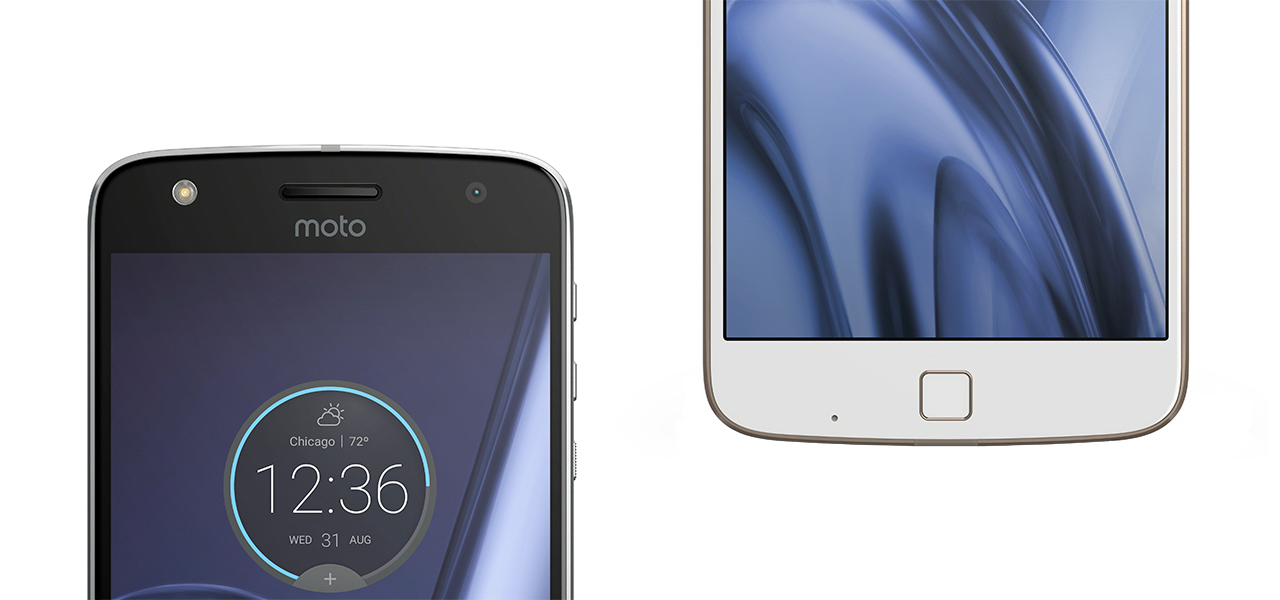
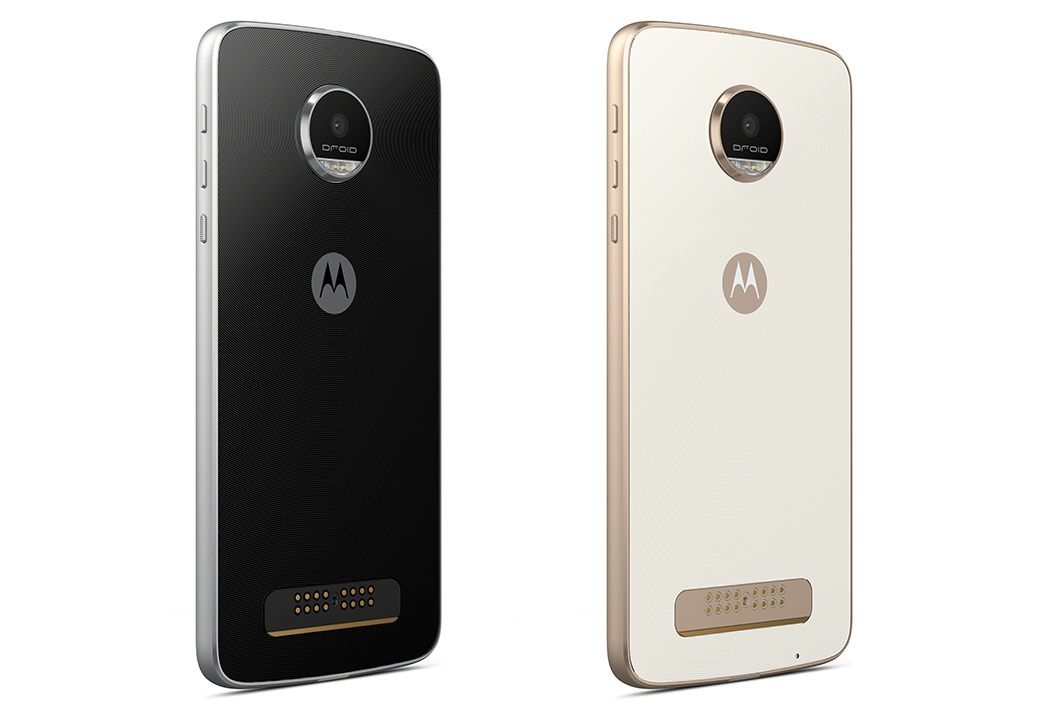








8 Comments
View All Comments
zeeBomb - Wednesday, August 31, 2016 - link
Ooh yeah. More RAM + Bandwidth topped off with the S625...more battery friendly!I'm sad with the price. In Canada this translates to $535, going in to the flagship prices here. Maybe with a Medium/Gold contract, it should be doable..
menting - Wednesday, August 31, 2016 - link
I have a feeling none of the models will sell well with those pricesevilpaul666 - Wednesday, August 31, 2016 - link
I was eagerly awating a followup to the 2015 Moto X Pure edition. It seems the Moto X might not be dead, but rumors are it's getting a SN6xx SoC and 4.6" screen.I briefly switched over to wanting a Moto Z instead, but between the pricing on all models and Motorola's unwillingness to release the monthly security updates to Android every month instead of every three months as reported by Ars Technica. That, and last year's Moto X Pure is apparently still on the February security updates and probably not ever getting Nougat I'm no longer planning on picking up anything Motorola at all.
Other companies are going to be shipping things with closer to stock Android which was one of the Moto X 2015's selling points as well.
Good bye, Moto!
JasonMZW20 - Wednesday, August 31, 2016 - link
Huh? 2015 MXPE is on May 2016 security update. I don't think it's feasible for manufacturers to release monthly security updates. Even a company as large as Samsung can only guarantee them for flagships, and only recent ones. Google is much better, but they also make Android, so it's expected on Nexus devices.The update situation is broken though. Linux kernels and binaries are tricky over tons of devices, and Qualcomm doesn't help matters by linking support binaries to specific Linux kernel versions. Want to end support? Move to a new Linux kernel version and kill support for older versions, and, therefore, older devices.
zodiacfml - Thursday, September 1, 2016 - link
If you ask me, yes. This year's Nexus (smaller version) is rumored to be $450 which has Snapdragon 820. I reckon, this Moto should be lower at $50 less.beginner99 - Thursday, September 1, 2016 - link
Too large like all Motorola phones.Infy2 - Thursday, September 1, 2016 - link
The rear camera is the same as in Moto G4 Plus.bj_murphy - Thursday, September 1, 2016 - link
I think Motorola is starting to differentiate their products too much... Just stick to 3 or 4 phones and only one in each "class". Moto E, Moto G, Moto X, Moto Z. Why are we getting all these different sub-models within each of the phone "letters"? If you ask me it just reminds me of the insane number different phone models available on various carriers on the Android side before about 2011 or 12, with very little consistent branding across carriers (the phones were being branded by the carriers more than the companies that were making the phone). Customers were effectively driven towards iPhone because it was so confusing trying to figure out which Android phones were any good, and finding things like phone cases could be next to impossible.Obviously Motorola isn't that bad right now but I don't like the direction they are moving with this.